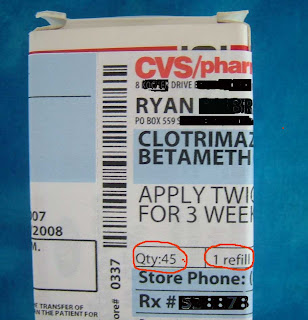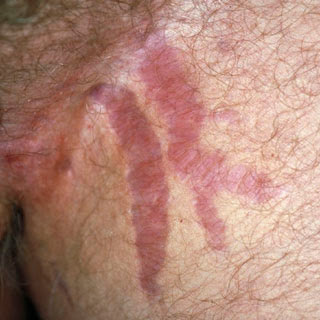He was prescribed Clotrimazole/betamethasone diproprionate cream to use b.i.d for three weeks. At the end of that time, he called his doctor and said he still had the rash. He relates that he was told to continue for another three weeks.


Shortly thereafter, he noticed a discoloration in his groin and some tingling and erythema of the scrotum. The exam showed striae in crural folds and perhaps mild scrotal erythema.
 Photo courtesy of DermNet
Photo courtesy of DermNetI see a few cases of striae secondary to this combination cream each year. The medication seems to have more risks than benefits. It should probably not be used for more than a week in groin or axillae. I have also occasionally encountered men with painful burning scrotums secondary to potent topical steroids (including this combination) and suspect that "scrotodynia" can be caused in this manner. This patient has mild symptoms scrotodynia, but I suspect they will resolve.
Here is a pertinent reference:
Clotrimazole/betamethasone diproprionate: a review of costs and complications in the treatment of common cutaneous fungal infections.
Greenberg HL, Shwayder TA, Bieszk N, Fivenson DP.
Pediatr Dermatol. 2002 Jan-Feb;19(1):78-81.
The use of antifungal/corticosteroid combinations as topical therapy for dermatophytoses has been criticized as being less effective, more expensive, and the cause of more adverse cutaneous reactions than antifungal monotherapy. The combination of clotrimazole and betamethasone diproprionate (Lotrisone) is a mix of an azole antifungal and a high-potency corticosteroid, and is one of the most widely prescribed of these combinations. Our objective was to describe the beneficial and deleterious effects of Lotrisone in the treatment of common cutaneous fungal infections and its relative cost-effectiveness. We did a literature review documenting clinical trial data and adverse reactions to Lotrisone and collected a cost analysis of topical antifungal prescribing data over a 2-month period from a large midwestern staff-model health maintenance organization (HMO). Lotrisone is approved by the U.S. Food and Drug Administration (FDA) for the treatment of tinea pedis, tinea cruris, and tinea corporis in adults and children more than 12 years of age. Treatment is limited to 2 weeks in the groin area and 4 weeks on the feet. The most concerning adverse effects of Lotrisone were reported in children and included treatment failure, striae distensae, hirsuitism, and growth retardation. This combination was also reported to have decreased efficacy in clearing candidal and Trichophyton infections as compared to single-agent antifungals. Lotrisone was considerably more expensive than clotrimazole alone and was found to account for more than 50% of topical antifungal expenditures as prescribed by primary care physicians, but only 7% of topical antifungals prescribed by dermatologists. We found that Lotrisone was shown to have the potential to induce many steroid-related side effects and to be less cost effective than antifungal monotherapy. This combination should be used judiciously in the treatment of cutaneous fungal infections and may not be appropriate for use in children.















0 comments:
Post a Comment